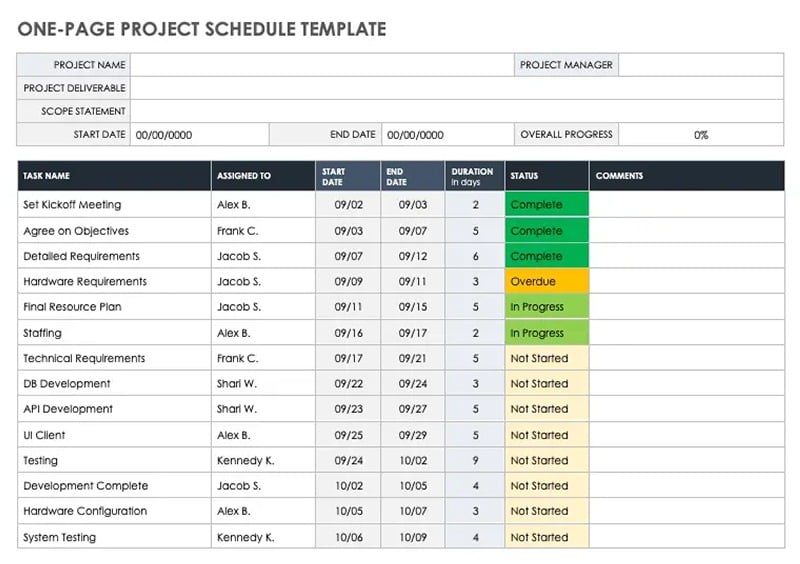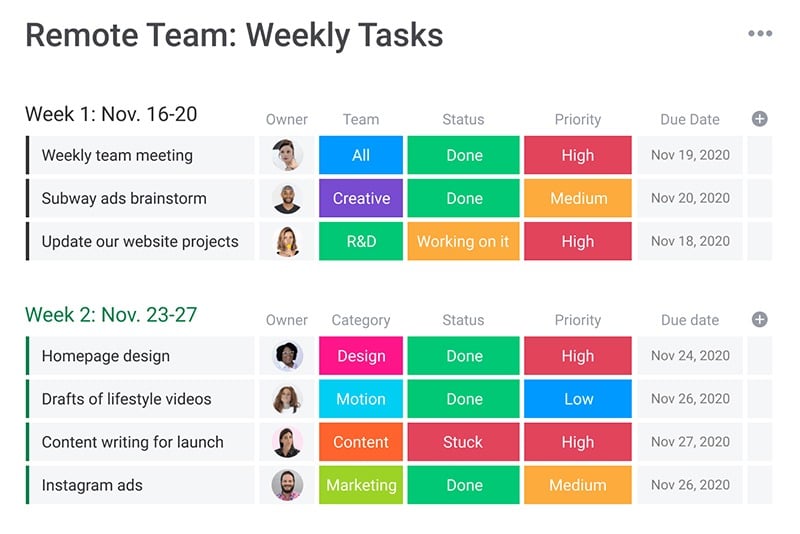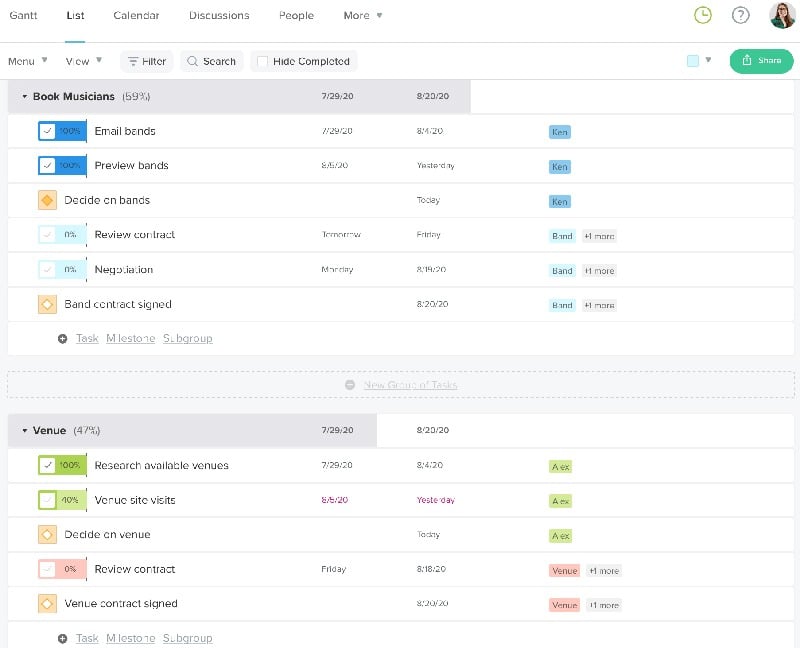10 Essential Features of Project Management Software in 2025

As a project manager, the process of managing a project can get overwhelming and time-consuming. You have to track multiple activities like tasks, resources, budgeting, meetings, and deliverables.
Successful project managers use project management systems to improve their project’s performance. While there are many PM software tools available in the market, finding the right one for your projects can be difficult.
When searching for the best project management software that guarantees project success, knowing what features you need is essential.
This article covers the 10 essential project management software features that can help you effectively manage simple and complex projects successfully.
Let’s get started.
1. Planning and Scheduling
Project planning and scheduling are essential parts of the project management process. The foundation of every successful project starts with the planning phase. A staggering 65% of projects fail. One of the leading causes of project failure is inadequate project planning.
Most project management software tools have project planning features that let you set project goals, plan your project tasks, and schedule how to execute them.

Creating a project schedule is crucial for tracking project progress. Smart project management software helps you create project timelines, automatically assign tasks to team members, track due dates, and set priorities.
When searching for a project management solution, choose one that lets you visualize your entire project. You can easily track pending and completed tasks with project visualizations.
With project planning software and project scheduling tools, project managers can easily manage their project plans online without having to manually reschedule them. Your team members can access the project schedule and track all the tasks and activities.

Ideal Users of the Project Planning and Scheduling Features
The project planning and scheduling features are ideal for every project manager, creative head, or team lead that wants to manage a project successfully.
Do you want to organize your project team for success, set realistic goals and timelines, and create a simplified project management process? Prioritize using project management software with project planning and scheduling features.
2. Task Management
Tasks are the building blocks of the project. Every project management tool has a task management feature. If you find one that doesn’t have this feature, it’s not a PM tool.
One of the essential roles and responsibilities of the project manager is to assign tasks to project teams. However, assigning tasks and managing their execution can be time-consuming.
Task management doesn’t have to be a complex activity. Three simple steps for effective task management include creating project tasks, organizing, prioritizing, delegating tasks, and monitoring progress and updates.
You can use task management software to manage your project workflows. But if you want to enjoy more project management features than assigning tasks and managing them, you need more comprehensive software.

Project management systems with extensive task management features help break your large projects into smaller and actionable tasks and delegate tasks effectively. You can identify and automate recurring tasks like team meetings and reports.
The task management feature prevents you from assigning the same tasks multiple times to the same individual.
If you are working on multiple projects, you can create project dependencies and group similar tasks and activities for faster and more successful completion.
Ideal Users of the Task Management Feature
The task management feature is ideal for anyone that wants to manage a project (project manager and non-project manager).
If you’re a project manager, team leader, or stakeholder managing large teams or multiple projects, the task management feature is essential for you.
3. Collaboration and Communication Tools
Collaboration and communication tools are crucial components of project management software. As a project manager, you are responsible for managing the project team and stakeholders.
If you are managing a large project team with remote members, keeping them on the same page can be tasking. Teamwork statistics show that 97% of employees point to the lack of alignment within a team as a leading factor that can affect a project’s outcome.
Team collaboration tools create an environment where every team member can interact with other project stakeholders and work together towards the project’s goals.
Many projects require team members to access each other’s work. The best team collaboration tools support sharing of files, calendars, lists, and resources among project team members.

Team communication features are essential for a project’s success. Poor communication between the various individuals, groups, and departments involved in a project can lead to a badly-run project.
The best team communication tools ensure everyone involved in the project, whether working remotely or in-office, stays on the same page.
Instead of using different software tools to manage your team collaboration and communication needs, use a project management tool that offers the desired features.
The best project management solutions have an in-built messenger app and an organized file-sharing system for quick and effective team communication and collaboration.

Ideal Users of the Team Collaboration and Communication Features
Every project team, irrespective of its size and complexity of the project needs a project management tool with team collaboration and communication features.
If you are managing remote teams with members split by different time zones, these features should be the top priority.
4. Documentation
Project documentation is the process of organizing and keeping records of the project data for future reference. Every document you produce or use during the project life cycle, like project proposals and status reports, makes up the documentation.
Project managers are responsible for recording the project data. Having such a database of information can prove valuable for future projects.
Many project teams fail to repeat the success they achieved in previous projects because they have no proper documentation of the process to serve as a guide. Even worse, project teams repeat the same mistakes that caused previous projects to fail because of poor documentation.
If you are using spreadsheets to store your project data, you are at risk of errors and inaccuracies. Organizing your project documents in one place for easy reach is nearly impossible with spreadsheets.
With a project management system, you can store and access your project data in one place and share it with team members and key stakeholders. There’s no need to switch from one app or spreadsheet to another.

Ideal Users of the Project Documentation Feature
The project documentation feature is ideal for every project manager and team leader that wants to learn from their mistakes and repeat their successful processes.
Instead of having to start every project from scratch, you can use the project documentation feature to access a similar past project and use it as a template.
5. Reporting and Project Files
Reports are one of the most desired project management features. There is no particular project that can thrive without using reports to track project performance. A whopping 54% of companies don’t have access to real-time KPIs.
There are six essential reports every project manager should track.
- Project status reports.
- Project health reports.
- Team availability reports.
- Progress reports.
- Project risk reports.
- Time tracking reports.
The reporting or project tracking feature lets you track your project performance in real time. You can easily set, track, and evaluate key performance indicators (KPIs) to determine the success and failure of your project.
Project managers use reporting tools to quickly identify issues that may arise during the project management process before it affects the outcome. For example, with detailed project reports, you can easily discover when the project is falling behind the set schedule.
Many project management systems automatically create progress reports that provide you, your project team, clients, and stakeholders with clear insights into where the project stands.
A typical project management software tool has many project templates, like pre-filled and customizable reports you can use to track your projects.
However, knowing the right project management metrics to track increases your chances of success. Do you want to track the project ROI or customer retention and loyalty? You can create multiple reports to track as many key performance indicators (KPI) for your project.
Choose a project management software that provides real-time reporting features and sends you instant notifications about your project progress.

Ideal Users of the Project Reporting Feature
The project reporting feature is ideal for project managers or team leads that need to track their project performance in real time. If you want to track a particular key metric, the reporting feature is essential in choosing a project management tool.
6. Resource Management
Resource management is the ability to allocate, manage, track, and maximize available resources to achieve the project goals and objectives.
Projects tend to have scarce resources that need to be properly managed to achieve their goals. The resource management feature helps the project manager allocate resources to the right individuals and teams.

If you want to manage complex projects successfully, avoid allocating project resources in a way that overwhelms or underworks team members.
Managing project resources can be tricky and stressful without using project management software. However, not all PM tools have competent resource management features.
The best project management tools help you schedule your project resources to ensure every team member has adequate resources needed to complete their tasks. These tools prevent situations where you overuse or over-assign resources.

Ideal Users of the Resource Management Feature
The resource management feature is ideal for project managers, team leads, PMOs, and top executives that want to manage limited resources to achieve their goals.
Project managers will find this feature helpful for tracking the health and effectiveness of their project team. The resource management feature ensures that the adequate materials and tools needed to complete the project are readily available.
7. Managing The Project Budget
Managing projects without first crafting a detailed budget is a recipe for disaster. Whether you are managing a small or large project, there are crucial project expenses you need to document and manage properly.
Using spreadsheets to track your project budget can be time-consuming and leads to inaccuracies and errors. A whopping 88% of spreadsheets have errors.
What’s the better option? You can use budgeting software tools to track your project budget efficiently. But this solution will force you to switch between two applications, your project management software and the accounting software.
A better solution is to use a project management software tool with quality project budgeting features. You can create a detailed financial plan for your individual projects and factor in relevant project expenses like materials, equipment, and labor.
Creating a project budget is the easy part. The hard work is in making the project stick within the set budget and produce the desired results. An IPMA report shows that only 36% of organizations deliver projects that are on a budget.
When choosing the best project management software tool for your projects, choose one that helps you track and manage your project expenses. Your ideal software tool should provide detailed reports about your budget performance.
The best project budgeting software provides you with weekly or monthly reports. You can set notification alerts to inform you when your team exceeds the set budget.

Ideal Users of the Project Budgeting Feature
The project budgeting feature is best for project managers that have a fixed budget to deliver the project. If you want to manage multiple projects successfully with varying budgets and moving parts, you need this feature to track the different expenses.
8. Time Tracking
Time tracking is one of the most used project management software features. Every project has a deadline. Without monitoring the time your project team spends on individual tasks, subtasks, and the entire project, you will struggle to meet up with set deadlines.
The time-tracking feature helps you know how much time your team spends on various tasks and activities. You can use this information to track the performance sheets of every team member and better plan for the next project.
You can use time-tracking software to track work progress and team performance. If you have employees that work on an hourly basis, you can use the time tracking feature to track their billable hours.
Smart project managers use PM software with integrated time-tracking tools to better track and manage time spent, project schedules, milestones, and deadlines.

Ideal Users of the Time Tracking Feature
The time-tracking feature is ideal for project managers or program managers that work on multiple projects or portfolios with strict deadlines. If you hire employees at an hourly rate, you can use this feature to track their billable hours.
9. Project Views
Every project management software solution allows users to view project data in different views. You can easily customize your project dashboards using multiple views for different target audiences.
For example, if you want to share project progress with senior executives, you can use the Gantt chart view. But if you want to collaborate with your agile team, you are better off using Scrum or Kanban boards.
Visual project management software lets you choose from a variety of views for better visualization of the project process.
- Gantt chart.
- Kanban board.
- Scrum boards.
- Calendar view.
- Project timeline.
- Task list.

Ideal Users of the Project Views Feature
The project views feature is essential for project managers and team leaders that work on different project types with different requirements and styles.
10. Integrations
Most project management software integrates with other business software. When searching for the best project management tools for your needs, pick a solution that can integrate with your essential business software tools.
The software integration feature helps you streamline your workflows and prevents you from switching between applications. You can access other connected applications with a few clicks from the dashboard of your project management application.
For example, if you want to send an email to a team leader, you have to switch from your project management app to your email app. But with a good project management system, you can send emails to any member of your team from within the system.
Some popular project management software integrations include:
- Customer Relationship Management (CRM) Software
- Email Marketing Services
- Accounting Software
- File Sharing and Cloud Storage Services
- Enterprise Resource Planning (ERP) Systems
- Marketing Automation Tools
- Business Process Management Systems
- Business Management Software
- Online Collaboration Tools
- Billing and Invoicing Software
Ideal Users of the Software Integration Feature
The software integration feature is best for project managers and teams that use multiple applications to execute projects. With this feature, they can connect their essential work apps with the project management software for easy access and management.
Best Project Management Software
Choosing a project management software can be tricky. Many project management software claim to have these essential project management software features. However, not all PM tools provide them to an acceptable standard.
Here are the best project management software tools that possess the ten essential features.
Monday.com
ClickUp
Wrike
Teamwork
Asana
Sources
Explore Further
- Best Agile Project Management Software
- Best Enterprise Project Management Software
- Best Online Project Management Software
- Best Project Management Software for Small Business
- Best Project Dashboard Software
- Simple Project Management Software